If you’re a baker or you love to bake, it’s crucial to know how cake pan conversions work. Cake pans come in different sizes and shapes.
So when a recipe calls for one type of pan, and you have a different type, it’s super handy to know how to adapt a recipe to fit the cake pans you do have! Plus, get your own printable chart (at the bottom of this page) that you can hang on your fridge for easy reference.
A detailed cake pan conversion article to show how you can substitute or adjust recipes to the type of cake pans you have.
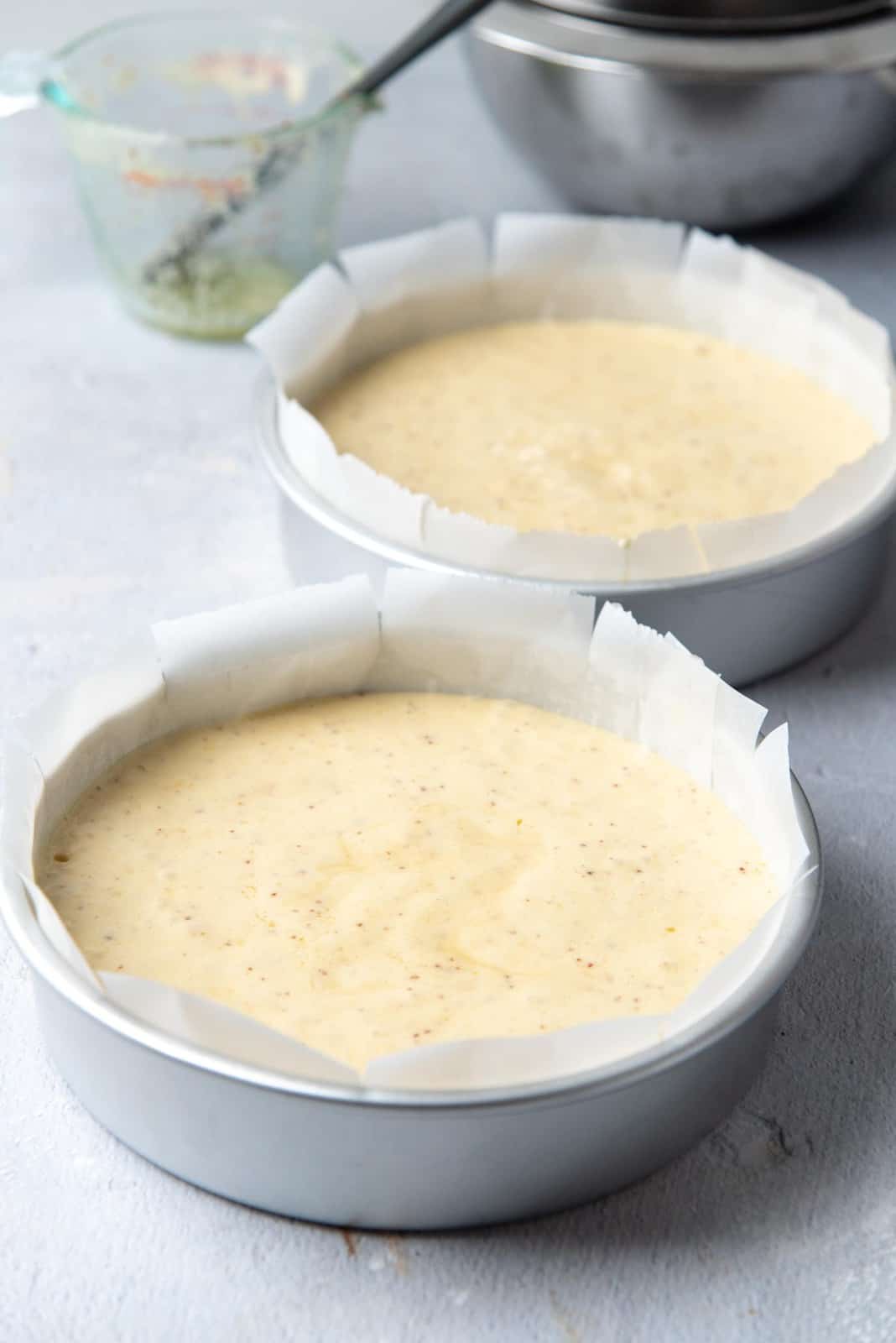
- What I cover in this article
- Types of pans used in baking
- Here are some important factors to keep in mind if you’re substituting cake pans in a recipe.
- Common cake pan conversions / calculations (by volume)
- Cake pan conversions / calculations (by area)
- How to calculate recipes for cake pans
- Calculating recipe adaptations – The formula
- Notes on calculations
Cake pans come in different sizes and shapes. Recipes usually tell you which pan you should use for that particular recipe, but what do you do if you don’t have the correct pan? I get a lot of questions from my readers on how to change or adjust a cake recipe from 3 layers to 2 layers, or how to make my fudgy chocolate brownie recipe in a half sheet pan instead of a square pan etc.
With this handy guide, you can learn how to adapt a recipe to the cake pans you do have at home!
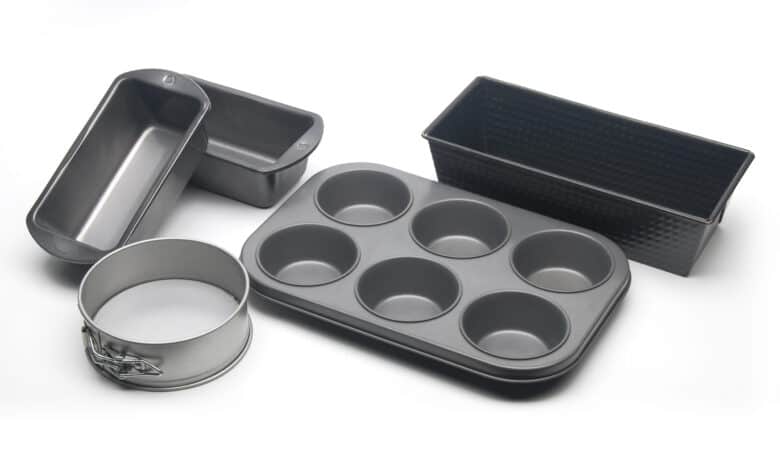
What I cover in this article
- Types of pans used in baking.
- Common cake pan conversions by volume and area.
- How to adjust recipes for different baking pans.
- How to substitute cake pans and the formula to use.
- Notes on making sure your recipe will still work.
Types of pans used in baking
There are many types of baking pans available out there. Along with a range of different ovens too. While this makes baking more accessible and convenient, it also makes it a little complicated when trying to adapt recipes for different pan types and sizes.
Metal pans
The usual standard for layered cakes is cake pans that are about 2 inches high. You can find these in different sizes ranging from 4 inches to 20 inches in diameter.
You can also easily find square or rectangle cake pans. Their height can range from 2 – 3 inches.
Loaf pans and bundt cake pans are also widely used in baking. These also come in different sizes.
Cake pans are mostly made out of metal because they better conduct heat. You can also find aluminum pans or non-stick pans. Plus they come in light or dark color as well.
Glass or porcelain pans
Next, you have glass and porcelain pans. Mostly used for making pies, and other baked goods, thicker glass pans are not as widely used for cake baking anymore. Baking in these pans takes longer because the glass / porcelain takes longer to heat effectively compared to metal pans, but they also do retain heat longer than metal pans.
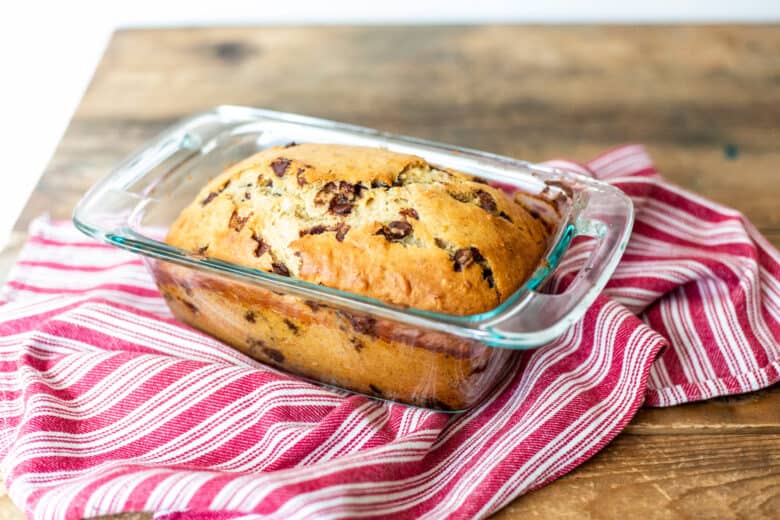
How to substitute cake pans
I get asked often by my readers whether they can make my classic vanilla cake in 9 inch pans instead of 8 inch pans. Or if they can make 2 layers of my classic chocolate cake instead of 3 as per the recipe. The answer to all of this is absolutely. But it does take a little math to figure things out.
Here are some important factors to keep in mind if you’re substituting cake pans in a recipe.
Keep the height of the cake the same if possible.
The height of the cake is determined by the depth of the batter in the cake pan. If the height is kept the same, calculating the cake pan size for conversion is easy. Plus it’s easier to calculate the area in a pinch instead of volume.
You will also need to ensure that the cake batter will not overflow from the cake pan that you’ll be using. Too little batter, and the cake can burn, or too much, and the batter overflows. So it’s important to not overfill the cake pan, and keep the height of the batter / cake the same.
Try to use the same type of cake pan as well.
If the recipe creator uses metal pans, try to stick with metal pans. Changing this to glass or porcelain will more than likely have an impact on the final result.
Be mindful of the nature of the recipe that you’re changing.
Usually cake recipes can be doubled, depending on the original recipe. However, if I’m making a double recipe that will result in a large volume of batter, I prefer to make single batches TWICE, rather than making double the amount. This is because making a double batch can affect the texture of the final outcome because it’s harder to mix ingredients well in larger volumes.
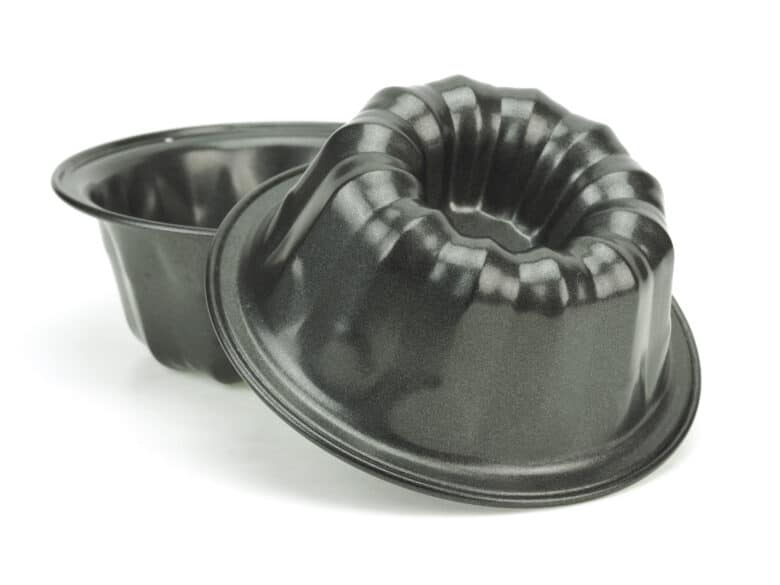
Common cake pan conversions / calculations (by volume)
For round pans = π r² h
For square / rectangle = length x width x height
Round pans (2 inches / 5 cm height)
6 inch round pan (15 cm) = 960 mL = 4 cups
8 inch round pan (20 cm) = 1.4 L = 6 cups
9 inch round pan (23 cm) = 1.9 L = 8 cups
10 inch round pan (25 cm) = 2.6 L = 11 cups
Square pans (2 inches / 5 cm height)
8 inch square pan (20 x 5 cm) = 1.9 L = 8 cups
9 inch square pan (23 x 5 cm) = 2.4 L = 10 cups
10 inch square pan (25 x 5 cm) = 2.8 L = 12 cups
Rectangular pans (2 inches / 5 cm height)
7 x 11 inches (18 x 28 cm) = 2.4 L = 10 cups
9 x 13 inches (23 x 33 cm) = 3.3 L = 14 cups
Half sheet pans (1 inch / 2.5 cm height)
9 x 13 inches (23 x 33 cm) = 1.9 L = 7 cups
13 x 18 inches (33 x 45 cm) = 3.7 L = 15 cups
Loaf pans (3 inches / 8 cm height)
8 × 4 inches (20 x 10 cm) = 960 mL = 4 cups
8.5 x 4.5 inches (21 x 11 cm) = 1.4 L= 6 cups
9 × 5 inches (23 x 13 cm) = 1.9 L = 8 cups
Jelly roll pans – (1 inch / 2.5 cm height)
10 × 15 inches (27 x 39 cm) = 2.5 L = 10 cups
12 × 17 inches (32 x 44 cm) = 2.8 L = 12 cups
Springform pans (2.5 inch / 6 cm height)
9 x 2.5 inches (23 x 6 cm) = 2.4 L = 10 cups
10 x 2.5 inches (25 x 6 cm) = 2.8 L = 12 cups
Bundt pan (Volume varies due to different shapes and designs. Assuming 3 inch / 8 cm height)
7.5 inches (19 cm) = 1.4 L = 6 cups
9 – 10 inch (22 – 25 cm) = 2.4 – 2.9 L = 10-12 cups
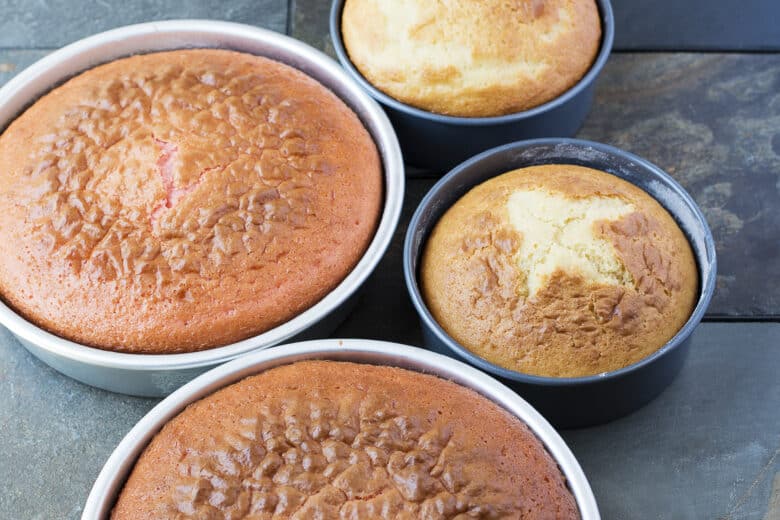
Cake pan conversions / calculations (by area)
Round pans = π r²
Rectangle / square pans = length x width
I use inches for these calculations for convenience.
Round pans (2 inch in height)
5 inch = 20 square inches
6 inch = 29 square inches
7 inch = 39 square inches
8 inch = 50 square inches
9 inch = 64 square inches
10 inch = 79 square inches
12 inch = 113 square inches
Square and rectangle pans (in inches)
6 x 6 inch = 36 square inches
7 x 7 inch = 49 square inches
8 x 8 inch = 64 square inches
9 x 9 inch = 81 square inches
9 x 13 inch = 117 square inches
12 x 16 inch = 192 square inches
13 x 18 inch = 234 square inches
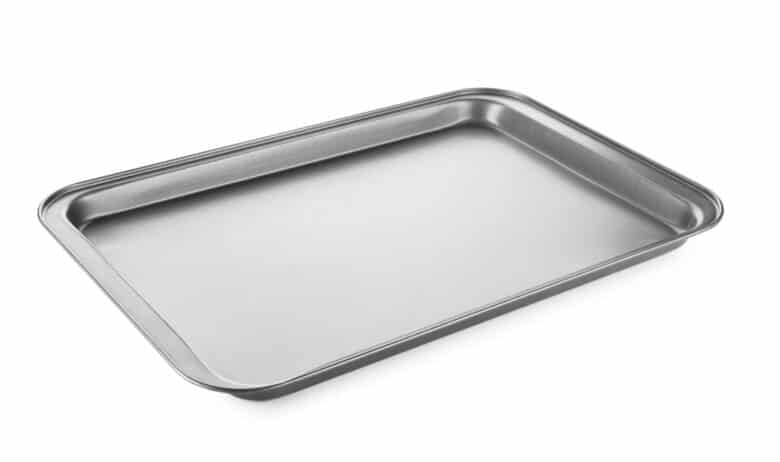
How to calculate recipes for cake pans
Being able to convert cake pan sizes and adapt recipes is easy, but requires just a little math.
For this, I usually calculate the area of the cake pans. I learned this method through Alice Medrich from Food52!
How to do the math
Let’s use my classic vanilla cake recipe as an example.
My vanilla cake recipe is baked in TWO 8 inch cake pans for a two layer cake.
But what if you don’t have two 8 inch cake pans? How do you change the recipe for the pans that you DO have?
9 inch round pans OR 9 x 13 rectangle pan
Let’s assume you keep the height of the cake the same to make the calculations easier.
Cake pan in my original recipe – Area of two 8 inch pans = 100 square inches
Area of 9 x 13 inch pan = 117 square inches
Area of two 9 inch round pans = 128 square inches
For 9 x 13 inch pan – cake pan ratio difference = 117 / 100 = 1.17 (~1.2)
Recipe conversion for the cake pan size you have – Multiply the recipe by 1.2 to get the correct amount of each ingredient to make ONE 9 x 13 inch cake pan, with the same height as the original recipe. However, the baking times will be longer due to the bigger cake pan.
For two 9 inch round pans – cake pan ratio difference = 128 / 100 = 1.28 (~1.3)
Recipe conversion for the cake pan size – Multiply the ingredients in the recipe by 1.28 (or approximately 1.3 times) to get the correct amount of each ingredient to make TWO 9 inch cake pans, with the same height as the original recipe.
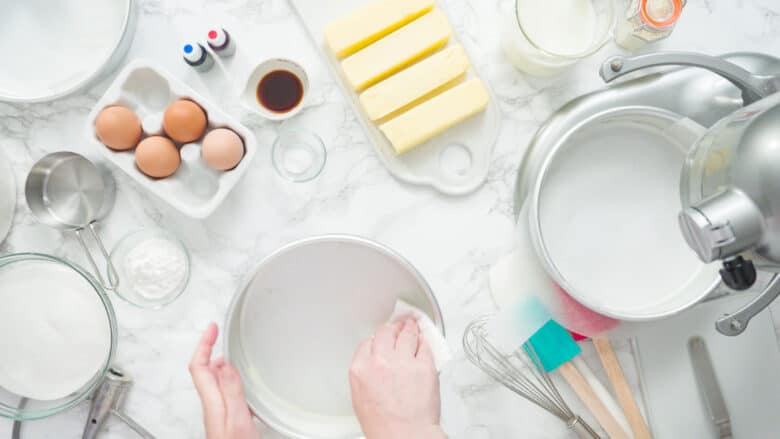
Here’s another example
How about a recipe that is baked in a 9 x 13 inch cake pan, but you want to make it in an 8 inch square cake pan?
Area of a 9 x 13 pan = 117 square inches
Area of an 8 inch square pan = 64 square inches
Ratio = 64 / 117 = 0.55
Multiply the recipe by 0.55 to get the correct amount of each ingredient to adapt the recipe for the smaller square baking pan, but make sure that the height of the cake pan is equal or greater than the original pan recommended.
You can also simply halve the recipe, OR make the full recipe and make it in TWO 8 inch square pans (but the height will be slightly shorter).
Volume calculations
Example – A cake recipe that uses two 8 inch pans that are 2 inches high.
Volume of the two 8 inch pans = 2 x 6 cups = 12 cups or 2.8 L.
Cake pan substitutions with similar volume capacities –
- 10 – 12 cup bundt pans – bake time will be longer and temperature will be lower due to the depth.
- 2 x 9 inch cake pans – cake layers will be shorter, so the bake time will also be less.
- 10 inch square cake pan – cake baking time will be longer.
- 10 inch springform cake pan – cake baking time will be longer.
- Two 8.5 x 4.5 inch loaf pans – baking temperature will be lower and baking time might be longer because of the depth of the batter.
- 9 x 13 inch cake pans – cake layer will be shorter and the bake time might be less.
Or use the formula below to change the ingredient amounts in the recipe to fit your new pan.
Calculating recipe adaptations – The formula
Area or volume of the cake pans used in the written recipe = X
Area or volume of the cake pan / pans you have available = Y
Ratio for calculating = Y / X = N
Multiply each ingredient amount by N to adapt the recipe for the cake pans you want to use.
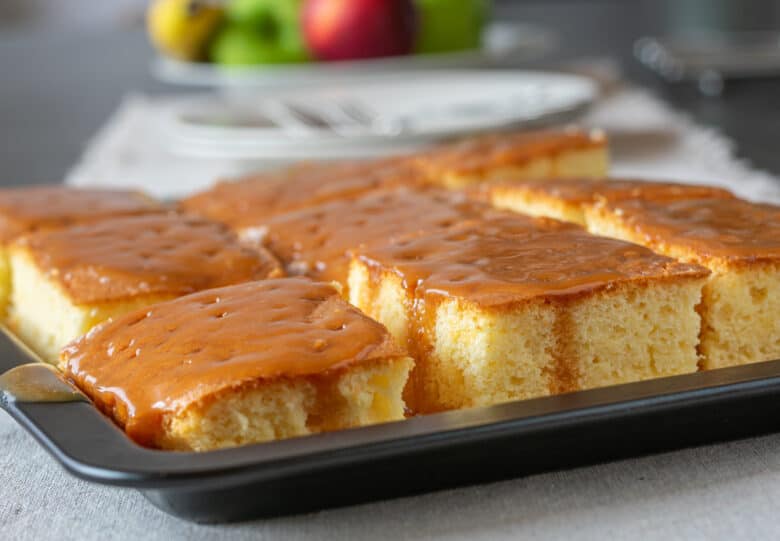
Notes on calculations
- This method of calculating will work as long as you use ONLY area or ONLY volume measurements for both the original pan and the one that you want to use.
- Compare the area or volume measurements of the original recipe to the other volumes in the table on this page, so you can find a comparable cake pan size, and how much batter you will need.
- There are still shortcomings with this method because some cakes / baked goods might not be designed to work in cake pans that have different height / depth.
- The baking temperatures and times can certainly change when you change the cake pan size.
- If you change the cake pan type (metal to glass or vice versa), the baking temperature and times will also change. The thicker the material, the slower the cake will bake.
- Also remember to never fill a cake pan more than 2/3 of the way. Otherwise, you will risk the cake batter overflowing.
- The volume measurements are for the ENTIRE pan filled with liquid, so keep that in mind when multiplying or adapting recipes to fit other pan sizes.
- When multiplying a recipe, please note that it’s generally not advisable to make large double batches of the original recipe. Because it’s harder to make sure that the ingredients are mixing evenly when the volume of the batter is so large. You risk ending up with undermixed batter, which will cause the baked goods to have uneven texture and flavor. Or if you overmix, you end up with a rubbery and tough end product.
Finally, if you don’t want to do the math..
If you want to skip the math, simply over-estimate how many batches of the baked good you need, and just fill the cake pans 2/3 of the way. Any extra cake batter can then be used to make cupcakes! Better to have too much than not enough in this case.
Printable!
For your own high resolution printable of the table above, you can subscribe to The Flavor Bender community to get this and other handy kitchen printables for free! Click on the button below OR the table above to join our community!
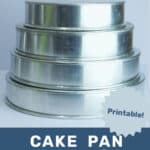
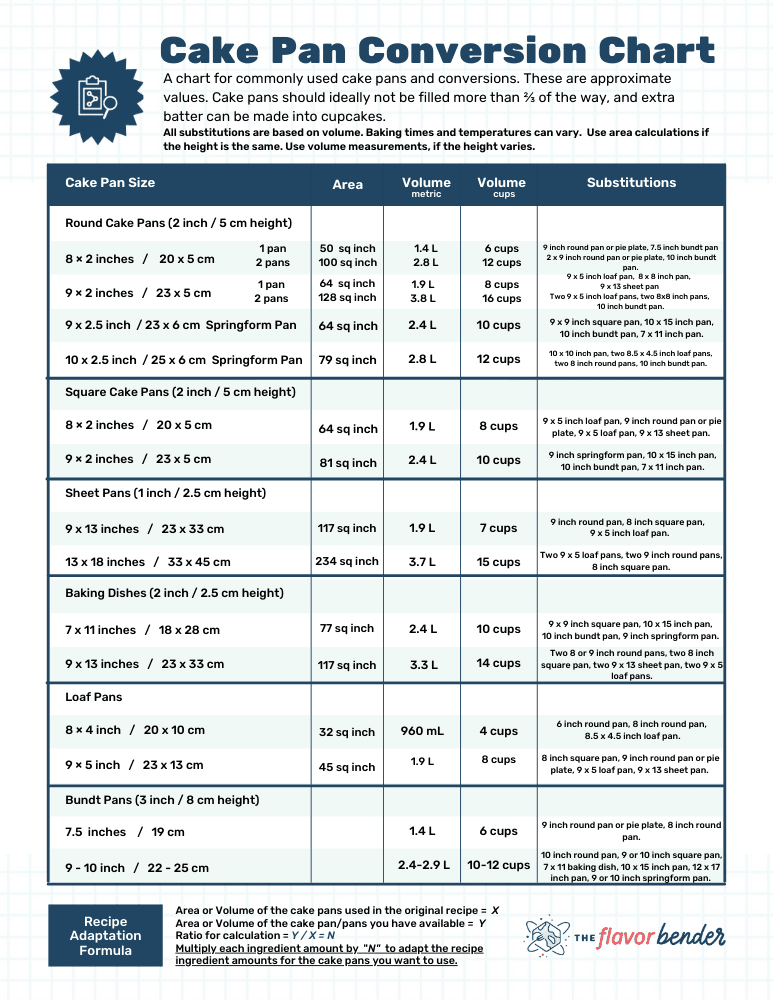
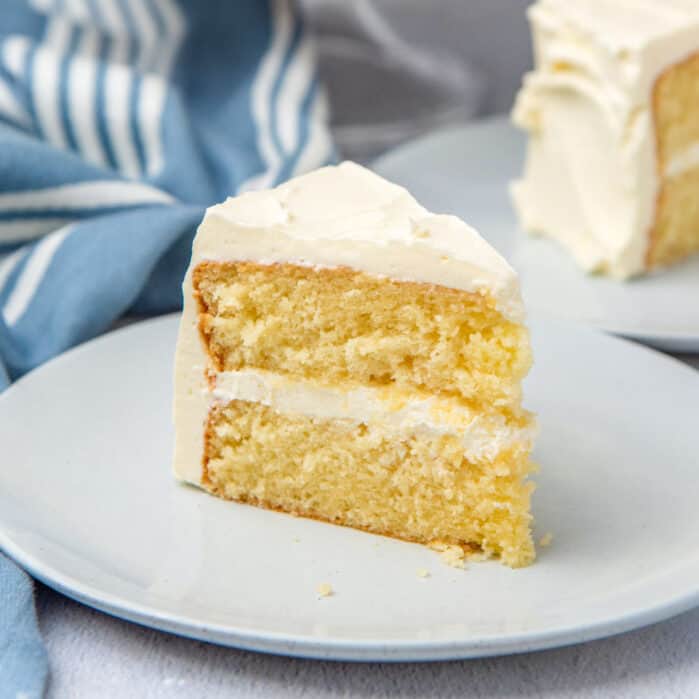
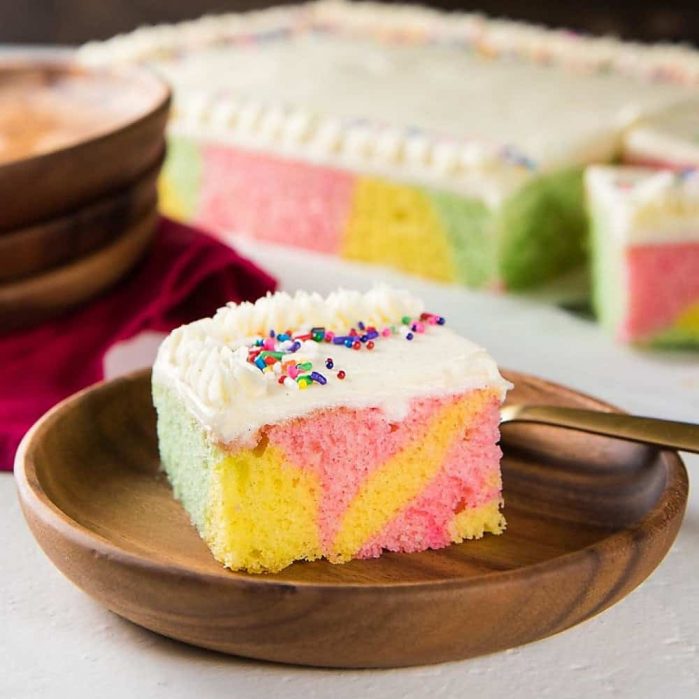
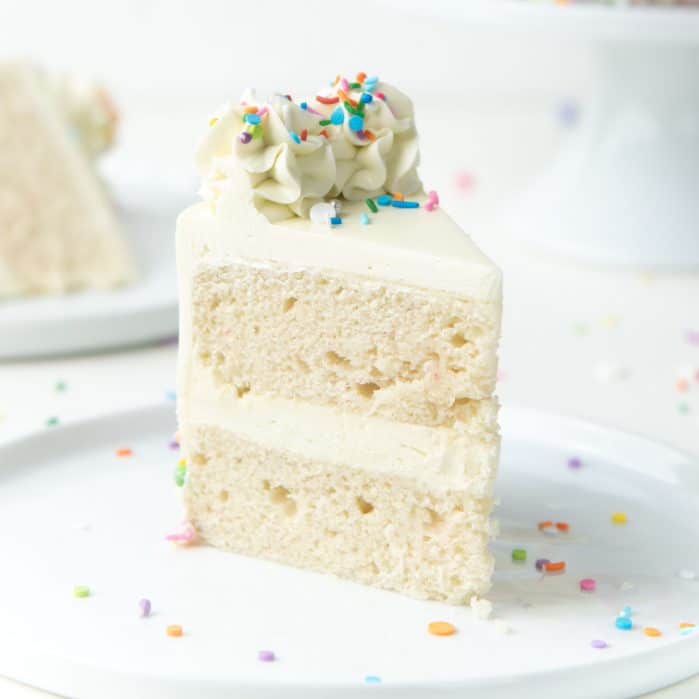
MG says
Godsend. a Thanks for existing